IOU
Many government scientists are furloughed because of the government shut-down. Many FEMA employees and meteorologists at the National Weather Service and National Hurricane Center are working for a "promise of pay" down the road. If only grocery stores and banks took IOU's.
Stating the obvious: meteorologists on TV and in the private sector rely on the raw data, models, satellite imagery and Doppler radar information provided by NOAA. It's the foundation upon which we interpret weather patterns and make our forecasts. Although data is still being transmitted, all maintenance has stopped, ongoing research on indefinite hold.
It's a happy coincidence that we haven't seen a major hurricane in the Atlantic or eastern Pacific in 2013, the first time since 1968.
Tuesday's soaking rain was a welcome sight, putting a big dent in our drought. A parade of increasingly chilly fronts in the next week will leave no doubt that it's October. Highs reach the 50s, a risk of frost Saturday morning with a better chance of a more widespread frost or freeze by the middle of next week.
You don't have to put in the driveway stakes yet, but ECMWF guidance shows a few flurries next Monday; our first real glimpse of winter.
Image credit: MPX Doppler site in Chanhasssen courtesy of Reid Wolcott.
"Private sector companies and broadcast stations," he says:
are essential partners in the weather enterprise. However, most of the satellite, Doppler radar, and observational data are from federal sources. The major forecast models are run at NOAA facilities. Federal predictions centers and Forecast Offices issue warnings. I can’t imagine a major potato chip maker saying that it could survive without potato farms. The point herein is that there is a vibrant public-private-academic partnership and each component is essential.(Emphasis mine.)
Those resources are still working, but all maintenance on them has halted. Many employees working at them have stopped being paid. American weather news depends on the American government..."
Texas Weather Whiplash: Drought To Flood Virtually Overnight. A month ago we were tracking historic flooding near Boulder. Now it's major flooding in Austin, Texas - the result of weather systems stalling once again, and a plume of tropical moisture streaming in from the Pacific. In today's Climate Matters we examine how "used" tropical systems spiked rain sparking severe flooding from Austin to Harrisburg: "WeatherNationTV Chief Meteorologist Paul Douglas goes over the flooding in Texas and how weather patterns have increasingly become "stuck".

* The Atlantic Wire has a good live blog of debt ceiling negotiations in Washington D.C.
How Your Knees Can Predict The Weather. It turns out that Grandma was right. Here's an excerpt of an interesting article at The Wall Street Journal: "...Still, other studies have linked changes in temperature, humidity or barometric pressure to worsening pain from rheumatoid arthritis and osteoarthritis, as well as headaches, tooth aches, jaw pain, scar pain, low-back pain, pelvic pain, fibromyalgia, trigeminal neuralgia (a searing pain in the face), gout and phantom-limb pain. Scientists don't understand all the mechanisms involved in weather-related pain, but one leading theory holds that the falling barometric pressure that frequently precedes a storm alters the pressure inside joints..."
Does Rainy Fall Weather Really Affect Your Brain, Mood? I found this article at AccuWeather interesting; weather has less to do with moods than the amount of daylight; shorter days can result in more fatigue. Here's a clip: "...What Denissen's research did show, however, was that the association between sunlight and tiredness was significant. The less sunlight people were exposed to, the more they exhibited depression-like symptoms. As the days get shorter, people may experience more feelings of fatigue during the day, difficulty rising in the morning when it is still dark outside and craving more carbohydrate-rich foods leading to weight gain, Kelly Rohan, Ph.D., Professor of Psychology, University of Vermont said...."


A Record-Setting Blizzard Killed 75,000 Cows And You Might Not Have Heard About It. Details from theblaze.com: "Ranchers
are still digging out thousands of their cattle that became buried in a
record-setting snowstorm in South Dakota late last week and over the
weekend. One would think the death of 75,000 cows by upwards of five feet of snow might get some national attention, but as one blogger observed, it has taken some time for the news of the precipitation massacre to reach outside of local media..."
Image above courtesy of Farm and Ranch Guide, which has more good information on the Black Hills blizzard's impact on the cattle industry.
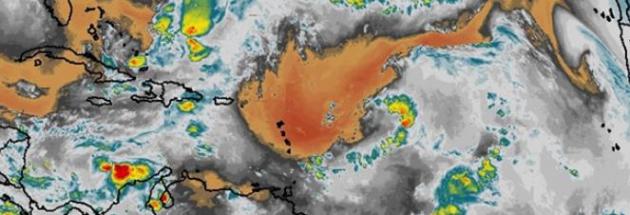
Tropics Extremely Quiet In Atlantic; Record Drought In Major U.S. Hurricane Landfalls.
No major hurricanes in the eastern Pacific or Atlantic for the first
time since 1968? Here's an excerpt of a good overview of what's going on
- or not going on, from Brian McNoldy at The Washington Post's Capital Weather Gang: "...And
this suppressed activity isn’t limited to just the Atlantic either.
The East Pacific has now had 14 tropical storms, but like the Atlantic,
no major hurricanes. This is extraordinary, since the two basins are
typically out of phase; that is, one is active while the other is
inactive. The only other year in recorded history in which no major hurricanes occurred in the Atlantic or the East Pacific is 1968..."
Image credit above: "Enhanced water vapor image from early this morning of the tropical Atlantic showing big pockets of dry air and strong wind shear." (NASA)
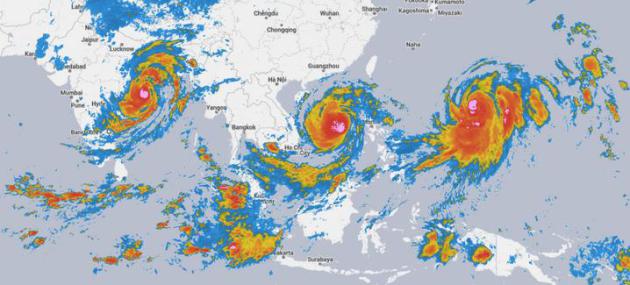
Atlantic Still Hurricane-Free, But Pacific Getting Pummeled By Typhoons.
Check out the enhanced IR satellite image above, showing Phailin, Nari
and Wipha - 3 major typhoons (same thing as a hurricane) pushing toward
India, Vietnam and Japan, respectively. Phailin and Nari have already
come ashore; Wipha will impact Tokyo as a category 1 storm early
Wednesday, local time. Details from Quartz: "While Cyclone Phailin—at one point, the strongest storm ever recorded in the Indian Ocean—makes landfall in India, two other tropical storms are also menacing Asia. The images above show the cyclone and two typhoons now. The first is from Weather Underground; the second, from Quartz meteorologist Eric Holthaus. Typhoon Nari tore through the Philippines with wind gusts up to 116 mph, killing at least 13 people and leaving 2.1 million people without electricity. The storm largely spared Manila, the capital city, which is prone to flooding..."
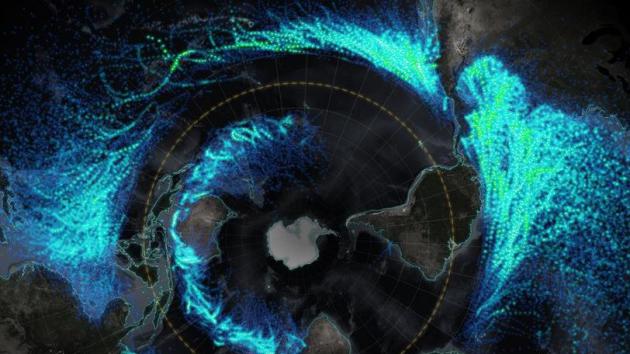


An American Shut-Down Reaches The Earth's End. The ongoing government shut-down is having a large, negative impact on research and science, worldwide, as reported by The New York Times; here's a clip: "...The
shutdown in Washington is being felt acutely at the ends of the earth.
Some 3,000 Americans work through the Antarctic summer, including
scientists and support staff from the private sector and from federal
agencies like the Defense and Energy Departments, NASA and the United
States Geological Survey. Amid the battle over the country’s spending
and debt limit, the National Science Foundation, which coordinates the
Antarctic program, has ordered it into “caretaker status,” which means
skeleton staffing. “All field and research activities not essential to
human safety and preservation of property will be suspended,” the agency
said in a statement last week..."
Photo credit above: University of Texas Institute for Geophysics. "Buried
ice sheets in Antarctica, left over from the last ice age, are melting,
and scientists may not be able to reach them this year."

POV Video Of A Space Jump. This is pretty amazing - check out the video courtesy of kottke.org: "A
year ago yesterday, Felix Baumgartner rode in a balloon up to a height
of almost 128,000 feet and jumped out. Red Bull, who sponsored the jump,
has finally released the full-length footage of the jump from
Baumgartner's point-of-view..."
A Junk News Diet. Democracy depends on an informed electorate, right? Uh oh. Here's a clip from an Op-Ed at U.S. News: "When balancing what you need to know vs. what you want to know in a news-infused media diet, news consumers most often choose dessert over vegetables, or sports, weather, entertainment and crime over national, international and business topics. Journalists at leading news organizations, however, choose to deliver more "vegetable" news stories over "sugary" offerings. This crucial news gap between news provider and news consumer threatens the viability of the public service mission of news organizations, and their contributions to the healthy functioning of the democratic process. What results is a potential crisis of news choices..."
It's Not Just Political Districts, Our News Is Gerrymandered Too. Cue the news media echo chamber ("tune in and we'll tell you want you want to hear") Dave Carr takes a look at how the segregation of news is contributing to dysfunction in Washington D.C. at The New York Times.
Peering Into The Future Of Media. I'm trying to pay attention to the trends and business models that have a prayer of surviving digital disruption; here's a clip from The New York Times: "...The convergence of digital media and technology, under way since the dawn of the Internet, will accelerate. Distinctions between old and new media will fade; most media will be digital. Mobile devices, already the preferred media and Internet platform for many people, will continue to proliferate. We may wear them on our bodies or weave them into our clothing. Globalization of the media business will advance, creating new markets. The old centers of media creation and consumption, the United States and Europe, will feel new competition from faster-growing regions: Asia, of course, but also Latin America, Africa and others. When that happens, media content, still dominated by Western notions of what constitutes news and entertainment, will have to adapt, too..." (image above: Huffington Post).

Photo credit above: "Chris Cox of Mount Pleasant, S.C., pushes a cart near the Lincoln Memorial in Washington, on Wednesday." Manuel Balce Ceneta/AP.



Climate Stories...
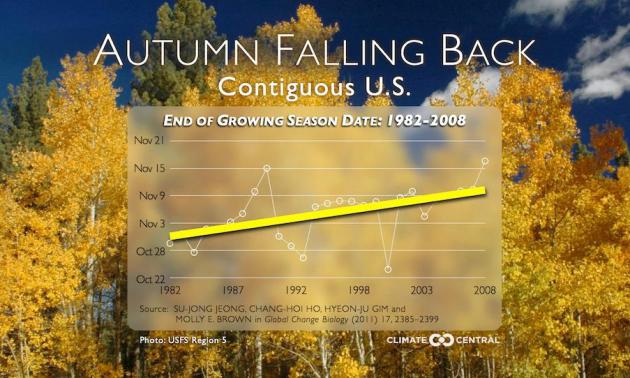
Foliage Season Under Fire From Climate Change. Climate Central has the story - here's an excerpt: "...The U.S. Forest Service estimates that fiery foliage in the Berkshires and Green and White Mountains generates $8 billion
in tourism revenue annually for New England alone. Foliage season is so
important to Vermont that the state employs a leaf forecaster. States
in other parts of the country also depend on foliage season to bring in
tourism dollars, though specific numbers are harder to come by. Warmer weather
is contributing to a later ending to the growing season in the U.S.
according to research from Seoul National University. The end of the
season is marked by the point when satellites see the overall greenness of foliage start to decline, was over two weeks later in 2008 compared to 1982..."
Image credit above: "The end of the growing season in the continental U.S. has become roughly two weeks later from 1982-2008."
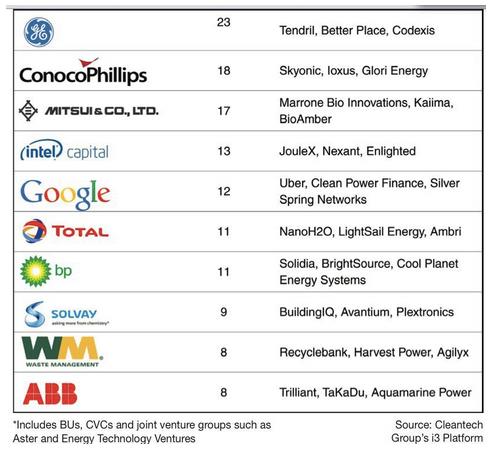
The Second Biggest Clean Technology Investor Is An Oil Giant. Here's an excerpt of a story at Quartz that caught my eye: "We’ve written before
about how big corporations have become increasingly important to
financing green technology startups—on Oct. 10 for example, Google
announced it was investing $103 million in a big solar power plant in California. But
the second-most active corporate dealmaker isn’t a “don’t be evil”
Silicon Valley tech giant. Rather it’s a company from the Dr. No
sector—oil multinational ConocoPhillips, according to a new report from research and advisory firm Cleantech Group. Between
the third quarter of 2011 and the second quarter of 2013,
ConocoPhillips invested in 18 deals, putting cash into startups such as
Cool Planet, biofuels developer, and Skyonic, which has invented a technology to capture carbon dioxide from industrial emissions..."

The Race To Understand A Changing Planet.
A guest lecture from the standpoint of former astronaut Dr. Piers
Sellers. Details from the Minnesota Climatology Working Group here.
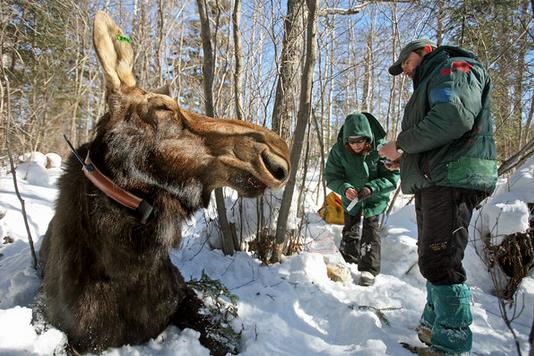
Moose Die-Off Alarms Scientists. One of the focuses of this New York Times story is Minnesota, where the moose population has dropped off significantly in recent years; here's an excerpt: "...Twenty
years ago, Minnesota had two geographically separate moose populations.
One of them has virtually disappeared since the 1990s, declining to
fewer than 100 from 4,000. The other population, in northeastern
Minnesota, is dropping 25 percent a year and is now fewer than 3,000,
down from 8,000. (The moose mortality rate used to be 8 percent to 12
percent a year.) As a result, wildlife officials have suspended all
moose hunting...“Something’s changed,” said Nicholas DeCesare, a
biologist with the Montana Department of Fish, Wildlife and Parks
who is counting moose in this part of the state — one of numerous
efforts across the continent to measure and explain the decline.
“There’s fewer moose out there, and hunters are working harder to find
them...”
Photo credit above: Brian Peterson/Minneapolis Star Tribune. "Mark
Keech, right, a research biologist, and Tiffany Wolf, a veterinarian,
fitted a moose with a radio collar and took samples as part of a
Minnesota study of why the animals die."
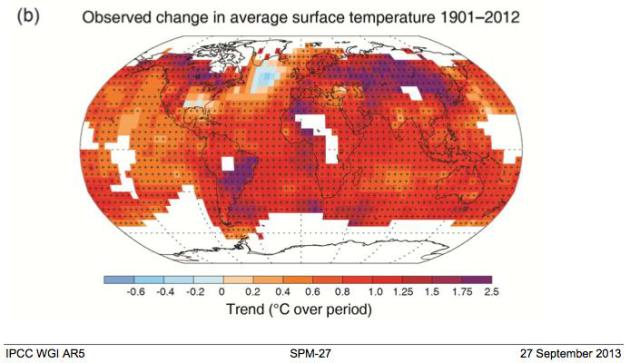
Politics Is Poorly Suited To Address Global Warming. Here's an excerpt of an Op-Ed at The Washington Post: "...However
the IPCC report is used or abused, it represents a consensus and not a
conspiracy. “Each of the last three decades,” it concludes, “has been successively warmer at the Earth’s surface
than any preceding decade since 1850.” The oceans have warmed and grown
more acidic. Ice sheets are losing mass. Sea ice and snow cover in the
Northern Hemisphere are shrinking. Ocean levels are rising. (Compared to
its report six years ago, the IPCC has raised its projection of sea-level rise
during this century by about 40 percent.) All these things are
plausibly related to increased atmospheric concentrations of greenhouse
gases produced in vast amounts by humans. And these trends involve
serious public risks..."

Global Warming - What's The Big Deal? Here is a clip of a reader Op-Ed at the Santa Fe New Mexican that caught my eye: "Global warming? What’s the problem? Personally, I don’t like cold weather and wouldn’t mind average temperatures being a few degrees higher than they are now. Unfortunately, global warming isn’t just about average global temperatures rising a few degrees by the end of this century. In fact, “global warming” misses the mark entirely when it comes to conveying the seriousness and urgency regarding what we’re collectively doing to the stability, and therefore livability, of our planet’s climate. “Climate chaos” may be more accurate..."



.jpg)


